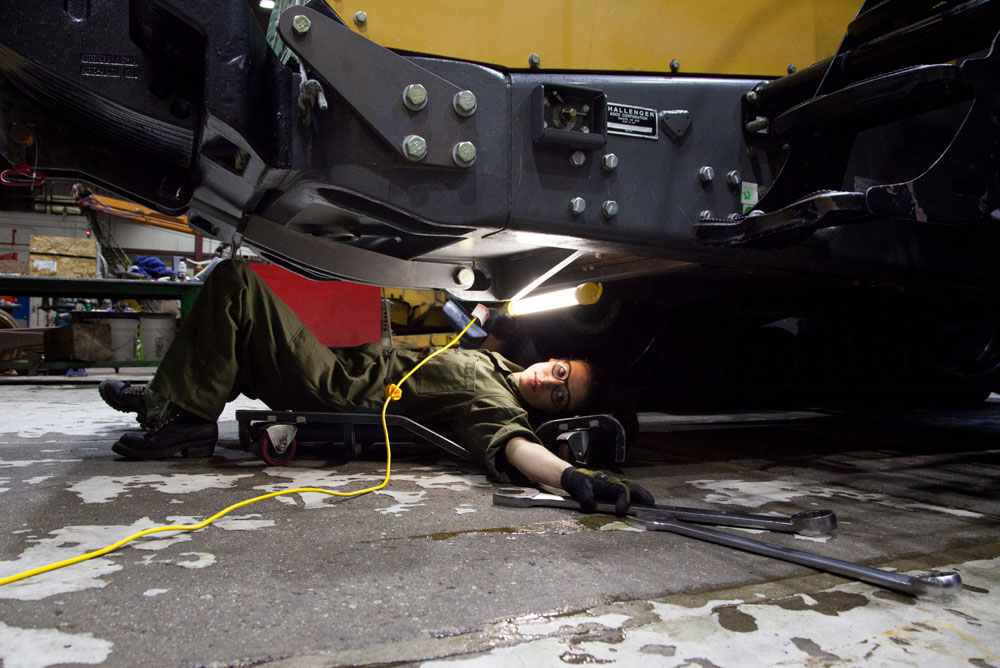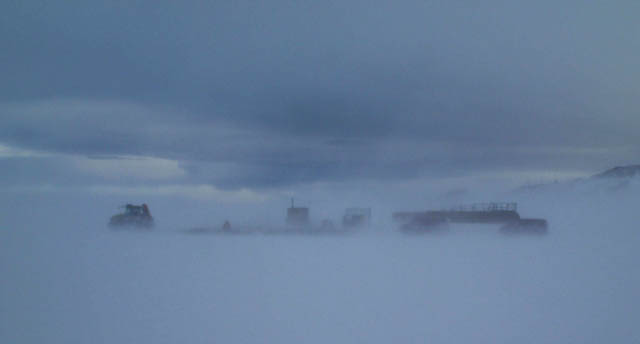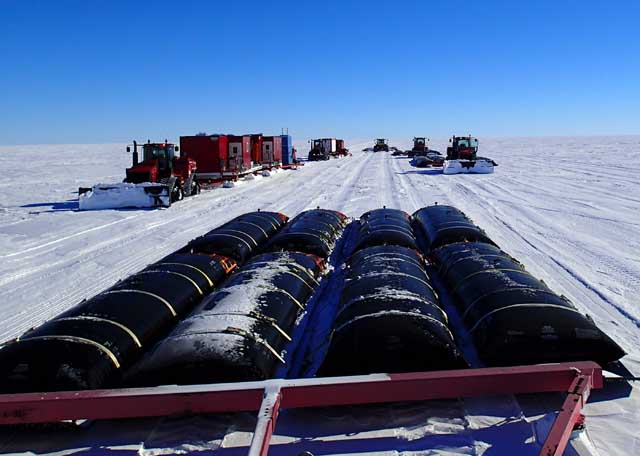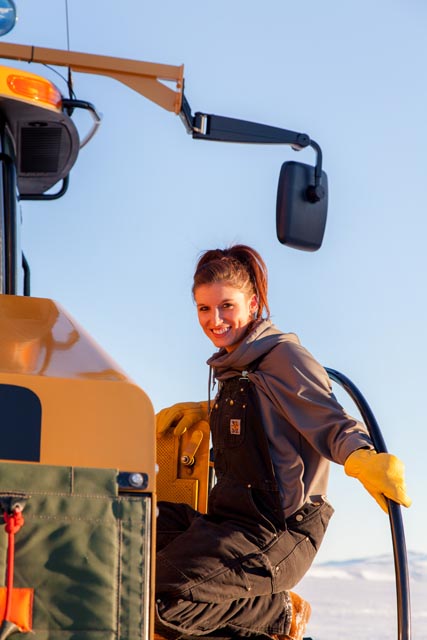
Photo Credit: Laura Gerwin |
Katy House reaches for a wrench while working on a Challenger tractor. At age 27, House is the first female mechanic to work on the South Pole Traverse. |
Crossing the gender gap
Katy House works as first female diesel mechanic on South Pole Traverse
By Laura Gerwin, Special to theSun
Posted January 2, 2015
Katy House thought she would live a fairly conventional life and be married with children at her age. Instead, at 27, she is the first woman in the world to travel on the thousand-mile-long South Pole operations Traverse, or SPoT, as a diesel mechanic.
And all because of a chance comment one afternoon two years ago.
As she was leaving work one afternoon in Spokane, Wash., Katy House’s boss asked her if she would be interested in taking a job in Antarctica as a diesel mechanic at the vehicle maintenance facility at McMurdo Station.

Photo Credit: Laura Gerwin
Katy House works on a traverse tractor.
“You want me to go where? I can’t go to Antarctica,” House responded.
“Why can’t you go to Antarctica?” asked her boss, Mark.
“Well, why can’t I go to Antarctica?” thought House, who grew up being encouraged, “to do whatever she wanted to do, whatever she loved.”
House eventually accepted the job at McMurdo Station. She now spends the austral summer driving 1,000-mile-long supply trips from one of the United States’ two year-round research stations to the other. At least three other women – Judy Goldsberry, Kristy Carney and Jennifer Teague – have driven on the traverse. House is the first to serve as the team's mechanic.
The mission for the team that travels the longest, coldest route on Earth is to re-supply the U.S. Antarctic Program’s Amundsen-Scott South Pole Station with fuel. The program is managed by the National Science Foundation.
Located in the middle of the windiest, coldest, driest, largest desert on Earth, Amundsen-Scott South Pole Station supports a variety of scientific research, with experiments focused around radio telescopes that are helping scientists to learn about the early universe, a massive sensor looking for elusive subatomic particles called neutrinos, and an observatory that monitors the levels of various gases, including greenhouse gases, in the atmosphere.

Photo Courtesy: Katy House
The traverse powers through a storm on its way between McMurdo and South Pole stations.

Photo Courtesy: Katy House
The traverse must cross rugged snow terrain known as sastrugi.

Photo Courtesy: Katy House
A view of a sled of fuel bladders and the rest of the SPoT tractor train.
Tractor drivers follow the traverse route, constructed on compacted snow, by following a line of flags in the ice and using a Global Positioning System.
House keeps the tractors in prime working condition. She says she finds it really rewarding when none of the equipment breaks down along the way because that means she did a really good job preparing the team’s tractors for departure. Her biggest challenge is working out in the cold, enduring some of the harshest weather conditions on Earth.
“Also challenging is going to the bathroom in a bottle with the tractor in motion,” House says, a common problem for women working in Antarctica, where, away from research stations and field camps, toilets are nonexistent.
Before departing McMurdo, it takes the team of 10 extensive preparation to fill the bladders used to transport fuel, prepare the equipment, and pack all of the supplies needed for life on the road.
First, the team must assemble the special sleds that hold the fuel bladders. Each bladder holds 3,000 gallons of fuel. House describes the fuel bladders as “sandwich bags full of liquid.”
The three South Pole traverses scheduled for the 2014-2015 austral summer will supply South Pole Station with more than half of the fuel it needs to operate for the next year. It takes the traverse anywhere from a record-setting low of 19 days to as many as 30 days to reach South Pole from McMurdo Station.
The rest of the needed fuel is flown in on New York Air National Guard Hercules LC-130 aircraft to ensure the station has enough fuel to endure the winter, when there are no flights or other way in and out of the isolated station.
House never imagined she would be doing anything like this. As a child, she spent time in 4-H Clubs raising and showing guinea pigs, rabbits and cats for competitions at the fair. She was also the Deer Park County Princess in Washington state.
Growing up playing with five sisters and two brothers, she says, “We got along so well you wouldn’t even know we were related.” She loved watching her Dad fix things. “He is really handy.” Her family is extremely supportive. Her little sister says she “wants to do awesome things just like Katy.”
Easy-going and friendly, House has lived her life with determination and adventure close to her heart. Home-schooled until her senior year of high school because the public school system pronounced her legally blind, telling her parents that she would never make it to her high school graduation.

Photo Credit: Laura Gerwin
Katy House
House graduated with her class and continued her education and eventually graduated with an associate degree in automotive technology and diesel heavy equipment mechanics. Spurred on by her love of mechanical work and her love of fixing things, House has always wanted to work on diesel engines and not automotive engines.
“I love tractors,” she exclaims. “I love being able to climb into my work.”
House enjoys figuring out how things work, and being able to repair them, which can be quite a creative process in Antarctica, considering you can’t just go down the street and get a part. The closest parts dealer, in fact, is in New Zealand. “Here we need to be able to fix things with the supplies we have on hand,” she explains.
Everyone on the team drives a tractor. The days are long, hard and cold – but they do it together, following one after another in a convoy.
"I love being able to climb into my work."
“We have a blast,” House says. “You pretty much just do the same thing over and over, so if something different happens, that is an exciting day. But if the trip is uneventful that means we are doing something right, which is also an amazing feeling.”
The team faces a variety of weather conditions en route. House says snowstorms can be, “mentally stressful, because you cannot see what is going on, as you are driving in a big white box.”
When the weather clears and the views reveal themselves, “some of the colors are almost indescribable,” driving between huge glaciers and seeing rocks in the distance that look almost red and purple.
One of her favorite parts of the journey is “driving up the Leverret [Glacier] and trying not to fall in any holes.”
The flagged route is pretty straight with only a few turns to make the entire way. When it is time to turn, the drivers have a bit of fun and use their turn signals.
House’s team plans to make two round trips this season before the winter descends on Antarctica. After prepping and breaking down her equipment and completing two of the three planned traverse missions, House will have been on the Ice for almost nine months.
Living life – doing what she wants to do and following her dreams – had made Katy House a part of polar history.










